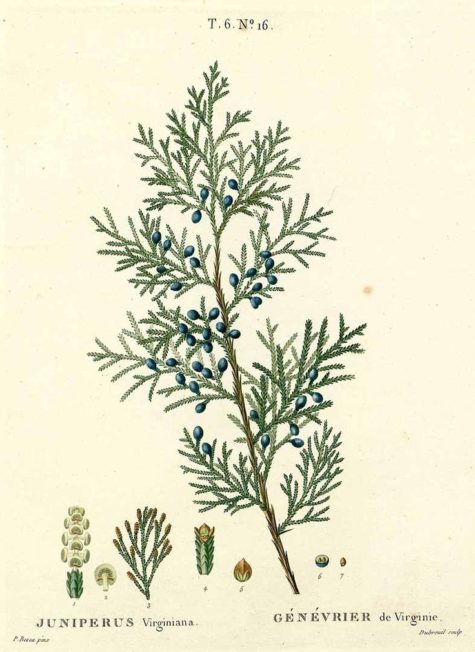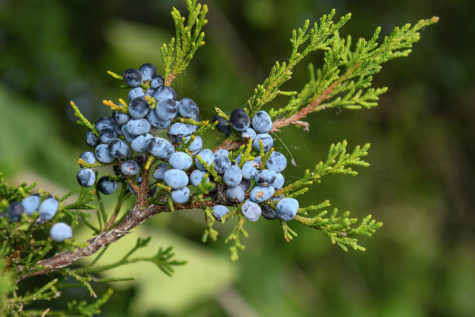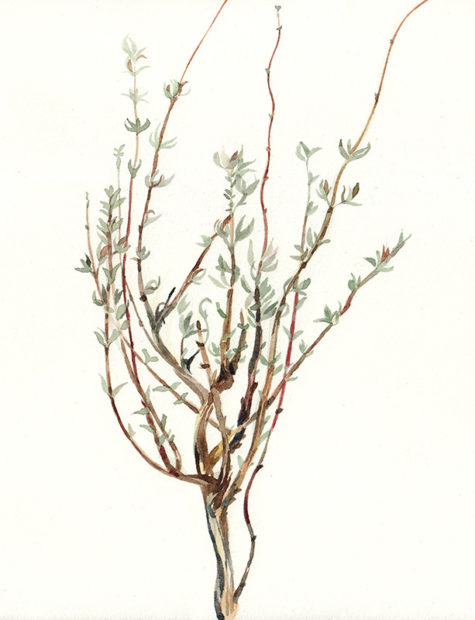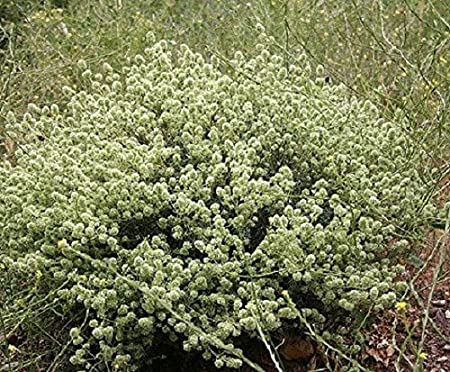Anti-inflammatory
Eastern Red Cedar
- Scientific Name: Juniperus virginiana
- Parts Used: Berries (female cones), branches, leaves, bark
- Actions: Anti-inflammatory, Diaphoretic, Expectorant, Astringent, Antimicrobial, Diuretic, Antiasthmatic, Antifungal
The uses of Eastern Red Cedar branch out into many. They are very similar to the Old World, standard Common Juniper in that its female cones- or berries- are one of its favored usable parts, if not an attribute of the plant that really grabs the eye. When you see the Cedar’s fragrant branches heavily-laden with these bright blue little “fruits,” it’s hard for an herbalist to think that these are NOT somehow useful!
One of the virtues of the berry is that it goes impeccably well with several mediums: salve, tincture, elixir, syrup, you name it. What more: it tastes delicious, and mixes well with a large variety of other herbal flavors in combination, if you are crafting a blend or formula of sorts. The twigs, leaves, branches and bark of Cedar have effects and flavor too, although they are notably more intense and astringent, having a reputation of being hard to extract; their use is important, but not as eclectic.
I would wager that the berries are more for tonic use, whereas the rest of this beautiful plant should be saved for acute situations, which I will get to later. Berries can be picked during the fall or winter, as they last, when they “ripen” to an appetizing-looking blue.
Remember: Cedar trees tend to be dioecious (at least the Eastern Reds are). That is, there are males and females of the species. If it is fall or winter, and the trees you are looking at for harvesting don’t seem to have blue cones, chances are they are male. Keep looking– you will more than likely stumble upon a female tree not far off.
In its many mediums, the berries serve as a very ideal winter medicine– all the better since they can, for the most part, be harvested all winter as the berries are available. They are high in Ascorbic Acid, or Vitamin C, an ideal vitamin to take over the winter for immune support. Even if you don’t have a cold, their use as a tonic will be more than welcome.
When winter illnesses take a nasty turn, Eastern Red Cedar berries work with expectorant action, helping the lungs clear out excess mucus and promote a healthy cough. It can be useful for a dry or wet cough: it relieves that “tickle” you may feel with a scratchy, dry throat with a hoarse cough, but it also stimulates the lungs to cough more productively, and expel phlegm in less time than without it. So here you have a medicine that stimulates the immune system, relieves a scratchy throat, improves your cough– and tastes great!
Cedar berries in syrup form are especially delightful. Sounds like quite a valuable ally to have, if you ask me.
Medicinal Uses
The young leafy twigs of the red cedar were officially listed in the U.S. Pharmacopoeia from 1820 to 1894 as a diuretic. The distilled oil of the red cedar has been officially listed as a reagent in the U.S. Pharmacopoeia since 1916.
The berries in decoction are diaphoretic and emmenagogue, like those of Common Juniper, and the leaves have diuretic properties.
People take Eastern red cedar for cough, bronchitis, joint pain (rheumatism), water retention, and flatulence. They also take it to improve appetite and digestion, and as a treatment for fungal infections and worms.
People apply Eastern red cedar to the skin for wounds, skin rashes, hair loss, eczema, acne, warts, fungal skin infections, and hemorrhoids. They also rub it onto joints for rheumatism, and onto the chest for asthma.
In the Native-Hispanic tradition, Cedars and their relatives are valued highly for the properties of their leaves, “needles,” or branches. These hold the more potent effects of the tree, and as such, are more difficult to capture in preparations. They can be slightly toxic.
The berries are used when there are excess fluids in the body, but Juniper really shines when the kidneys are sluggish, dilating tissues to increase urine flow, and reducing excess mucus production. It’s diuretic actions are truly remarkable, and is indicated in many cases of edema. Those berries are irritating, though, and are not recommended in large doses, for long-term use, and definitely not for those with kidney problems.
Eating 3-5 fresh berries is suggested for an upset stomach. It is thought the bitter nature stimulates gastric juices and improves digestion.
While certainly not widely considered poisonous or dangerous, it is still good to be careful. Be sparing when using preparations of Cedar needles or branches, even the berries, for that matter. Cedars are very powerful diuretics. When taken overboard, they cause kidney irritation, which feels like cramping in the abdomen– similar to a period cramp. Even higher doses can be more dangerous. Folks with weak kidneys, or outstanding kidney issues should avoid using the Cedar leaf.
Mastic Thyme aka Spanish Marjoram
- Scientific Name: Thymus mastichina
- Common Name: Spanish Marjoram
- Plant Family: Lamiaceae or Labiatae
- Parts Used: Leaves, Flowers, Essential Oil
- Actions: Antiseptic, Deodorant, Disinfectant, Analgesic, Anti-inflammatory, Antibacterial
General Overview
Thymus mastichina is a very special thyme, native in the mountains of the Iberian Peninsula, Central Spain and Portugal. It is known by a number of different common names including Spanish Marjoram, Spanish Wood Marjoram, White Thyme, Wild Marjoram or Mastic Thyme. The leaves, and especially the essential oil contained in them, are strongly antiseptic, deodorant and disinfectant.
Thymus mastichina should not be confused with Marjoram also known as sweet Marjoram, knotted Marjoram and previously classed as Marjorana hortensis (Origanum majorana). Nor should it be confused with the Mastic Tree (Pistacia lentiscus).
As the name implies it grows primarily in Spain. Thymus mastichina produces tiny, oval-shaped, green leaves, which have an intense flavor. In its Spanish homeland it is used as a culinary herb for meat dishes, stews and sauces and because of its strong aroma has been commonly used in Andalucía to season and preserve olives.
Despite this fact, it is prized more for its essential oils than for its herbal properties. The plant has an herbaceous scent with eucalyptus-like overtones with a hint of a vanilla note, which, in aromatherapy, is used for its soothing, relaxing effect. It’s oil is pale orange to amber in color and has a distinctive eucalyptus like aroma. It is also considered to be especially beneficial in relaxing muscles.
Used fresh or in dried form, its leaves are used to make an herbal tea that is considered useful in treating sore throats, catarrh and colds. If preferred, the tea can be used to gargle with rather than ingested. Infusions are attributed curative or palliative properties of arthritis and rheumatism. Mastic Thyme, may be effective in protecting against colon cancer.
The Basics
The species name mastichina and the common name of Mastic Thyme derive from the Greek word massein, meaning ‘to chew’, or the verb mastichein meaning ‘to gnash the teeth’. It is the origin of the English word masticate.
Interestingly, the Mastic Tree is a small Mediterranean evergreen tree (Pistacia lentiscus) of the cashew family. The tree produces an aromatic, ivory-coloured resin, also known as mastic, is harvested as a spice from the cultivated mastic trees grown in the south of the Greek island of Chios in the Aegean Sea. Mastic resin is a relatively expensive kind of spice that has been used principally as a chewing gum. The flavor can be described as a strong, slightly smoky, resiny aroma.
Mastic Thyme produces tiny, oval-shaped, green leaves, which have an intense flavor. In its Spanish homeland it is used as a culinary herb for meat dishes, stews and sauces and because of its strong aroma has been commonly used in Andalucía to season and preserve olives.
Despite this fact, it is prized more for its essential oils than for its herbal properties. The plant has an herbaceous scent with eucalyptus-like overtones with a hint of a vanilla note, which, in aromatherapy, is used for its soothing, relaxing effect. It is also considered to be especially beneficial in relaxing muscles. The essential oil is most often found under the name: Spanish Marjoram.
Used fresh or in dried form, its leaves are used to make an herbal tea that is considered useful in treating sore throats, catarrh and colds. If preferred, the tea can be used to gargle with rather than ingested. Infusions are attributed curative or palliative properties of arthritis and rheumatism.
The leaves are used as a seasoning. They have a pungent eucalyptus-like aroma. If the leaves are to be dried, the plants should be harvested in early and late summer just before the flowers open and the leaves should be dried quickly. The plant is also the source of an essential oil, called “oil of marjoram” or “Spanish Marjoram”, that is used extensively as a flavoring for soups etc.
The essential oil obtained from the leaves is also used in perfumery, as a mouth wash, medicinally etc.
Rennie Luttrull: queen-annes-lace-seeds
Rosanna: Spignel aka Bald Money
Annamarie Squatrito: Fumitory
EILEEN Klinghagen: Pumpkin
Mahmudul Hasan: Celery





